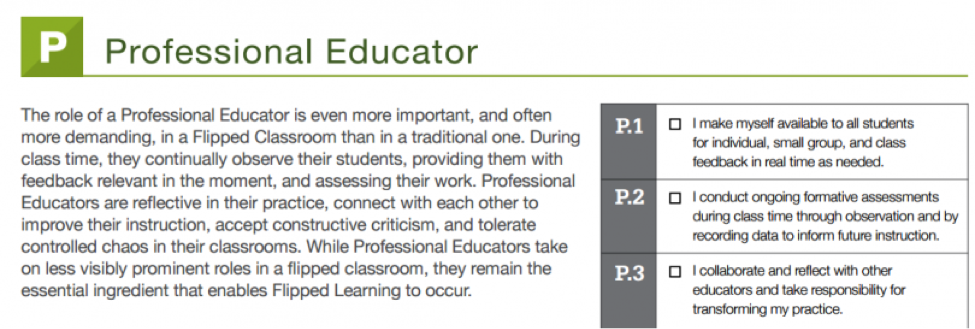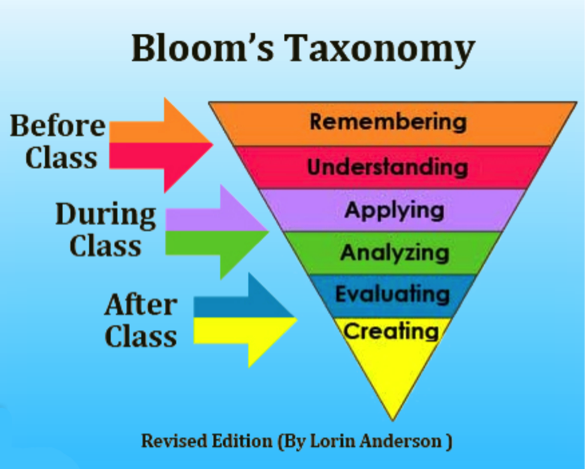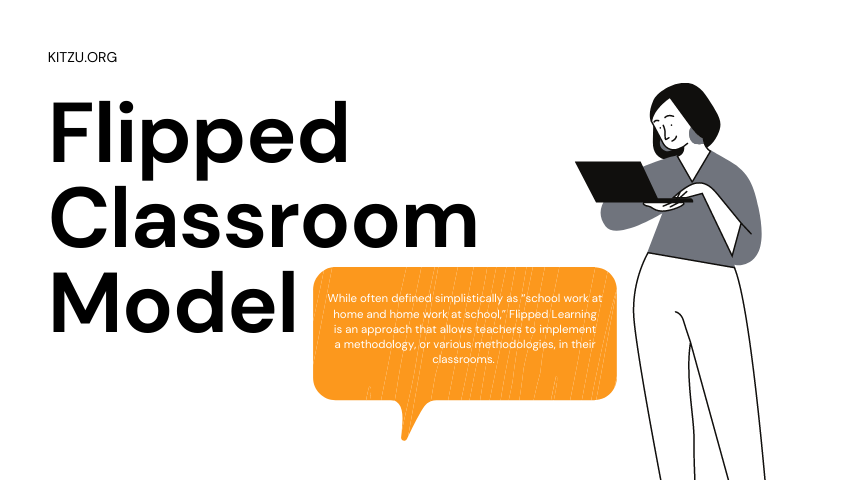What is a Flipped Classroom?
Flipped classroom is a “pedagogical approach in which direct instruction moves from the group learning space to the individual learning space, and the resulting group space is transformed into a dynamic, interactive learning environment where the educator guides students as they apply concepts and engage creatively in the subject matter” (The Flipped Learning Network, 2014).
The Four Pillars of F-L-I-P™




Fitting with the revised Bloom’s Taxonomy
In traditional learning, lower level of learning such as remembering and understanding is happening in class, while students are usually left to work on activities that involve higher level of learning outside of classroom. However, in the flipped classroom model, learning is flipped. As you can see from the pyramid, students can finish the lower level of cognitive work before class. And when they come to class, they can engage in higher cognitive levels of learning with peers and teacher present.

Why You Should Flip Your Classroom?
The concept of flipped classroom was first brought up by Jonathan Bergmann and Aaron Sams, who were both high school chemistry teachers. In their book: Flip your classroom: Reach every student in every class every day (2012), they discussed a couple of reasons why teachers should consider flipping (p.20-33):
- Flipping speaks the language of today’s students.
- Flipping helps busy students.
- Flipping helps struggling students.
- Flipping helps students of all abilities to excel.
- Flipping allows students to pause and rewind their teacher.
- Flipping increases student-teacher interaction.
- Flipping allows teachers to know their students better.
- Flipping increases student-student interaction.
- Flipping allows for real differentiation.
- Flipping changes classroom management.
- Flipping changes the way we talk to parents.
- Flipping educate parents.
- Flipping makes your class transparent.
- Flipping is a great technique for absent teachers.
- Flipping can lead to the flipped mastery program.
A sidebar in this book also cites 5 “bad reasons for flipping your classroom” (p.21). It is important for teachers to move beyond these perceptions.
- Because some guys who got a book published told you to.
- Because you think it will create a 21st-centry classroom.
Pedagogy should always drive technology, never the other way around.
- Because you think you will become cutting edge.
Flipping does not necessarily use the latest technology.
- Because you think flipping your classroom exempts you from being a good teacher.
Teaching is much more than good content delivery.
- Because you think it will make your job easier.
Flipping will not make your job any easier.
How To Implement A Flipped Classroom?
Jeff Dunn (2014) has wrote a short piece on “The 6-step guide to flipping your classroom”, which presented 6 easy steps for implementing flipped classroom.
- Plan
Figure out which lesson in particular you want to flip. Outline the key learning outcomes and a lesson plan.
- Record
Instead of teaching this lesson in-person, make a video. A screencast works. Make sure it contains all the key elements you’d mention in the classroom.
In Bergmann and Sams’ book (2012), they also pointed out that do not make a video just for the sake of making a video. Only do so when you feel these are appropriate and necessary. It all depends on the educational goal of your lesson. If making videos better facilitate your instructional goal, then go ahead.
- Share
Send the video to your students. Make it engaging and clear. Explain that the video’s content will be fully discussed in class.
- Change
Now that your students have viewed your lesson, they’re prepared to actually go more in-depth than ever before.
- Group
An effective way to discuss the topic is to separate into groups where students are given a task to perform. Write a poem, a play, make a video, etc.
- Regroup
Get the class back together to share the individual group’s work with everyone. Ask questions, dive deeper than ever before.
After the six steps, Review, Revise, and Repeat!
Some other strategies that can be used in in-class activities include:
- Active learning. Allow students to apply concepts in class where they can ask peers or instructors for feedback and clarification.
- Peer instruction. Students can teach each other by explaining concepts or working on small problems.
- Collaborative learning. Collaborative learning activities could increase student engagement, enhance student understanding, and promote collective intelligence.
- Problem-based learning. Class time can be spent working on problems that can last for the duration of a semester.
- Discussions or debate. Give students the opportunity to articulate their thoughts on the spot and to develop their arguments in support of their opinions or claims.
What Has Recent Research On Flipped Classroom And Medical Education Suggested?
A most recent systematic review (Chen, Lui, and Martinelli, 2017) examined 46 articles on the effectiveness of flipped classrooms in medical education with different learning outcomes.
- The effect of flipped classroom
This review suggested inconsistent findings regarding the effects of flipped classroom in student learning, with some suggesting benefits while others reporting negligible improvement over traditional teaching methods.
- Perceptions of flipped classroom
“Students were generally satisfied with the approach, particularly the usefulness of the online modules, because of easy access to resources for self-paced learning” (p.590).
- Attitude changes after using the flipped classroom
Positive changes were reported in this review study. Studies have suggested that medical students reported increased enjoyment, decreased boredom, and greater task value in flipped classroom.
- Knowledge, skills and behavior changes with the flipped classroom curriculum
Mixed results were detected regarding students’ changes in knowledge and skills with the flipped classroom versus the traditional lecturing. Similar to student learning outcome, some studies found positive results while others suggesting no differences.
This review further provided several suggestions for future research. First, future research in flipped classroom and medical education should try to take students’ compliance with the flipped classroom requirement into account. Other confounding variables may include time spent in class, outside of class and in clinical work. Second, future research could examine the differences of flipped classroom on knowledge requiring different cognitive levels. Third, future research could use change in attitude as a moderator to examine the effect of flipped classroom on knowledge acquisition. Finally, students’ knowledge retentions and transfer of knowledge to professional practice would be worthy of examination.
REFERENCES
Bergmann, J., & Sams, A. (2012). Flip your classroom: Reach every student in every class every day. Eugene, Or: International Society for Technology in Education.
Center for Teaching Innovation at Cornell University. (2017). Flipping the classroom.
Chen, F., Lui, A. M., & Martinelli, S. M. (2017). A systematic review of the effectiveness of flipped classrooms in medical education. Medical Education, 51(6), 585–597. https://onlinelibrary.wiley.com/doi/10.1111/medu.13272
Dunn, J. (2014). The 6-step guide to flipping your classroom.
Flipped Learning Network (FLN). (2014) The Four Pillars of F-L-I-P™


